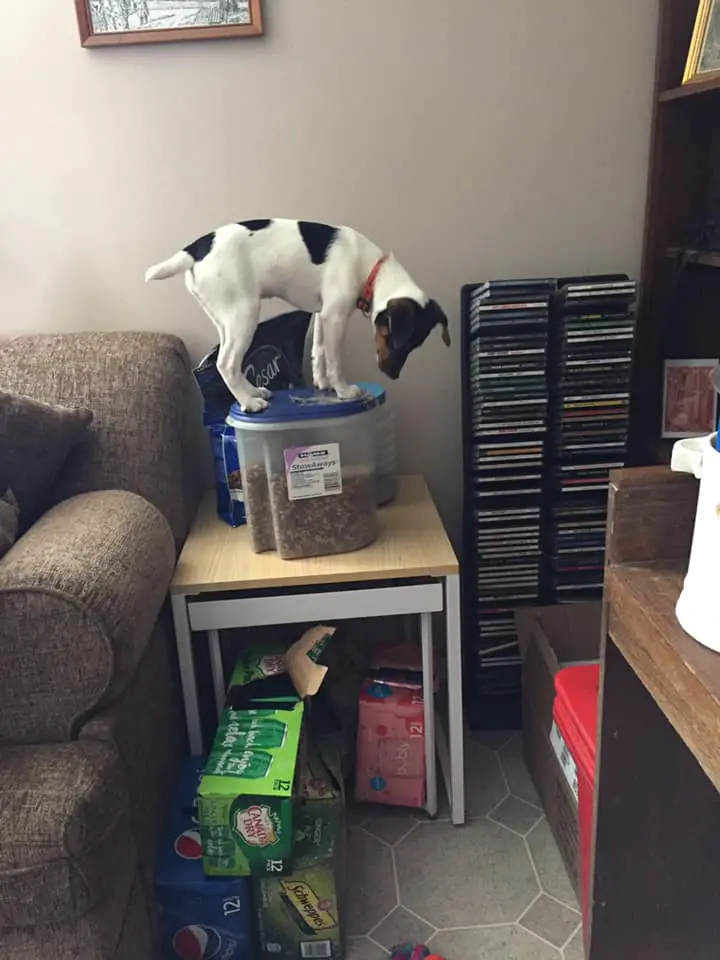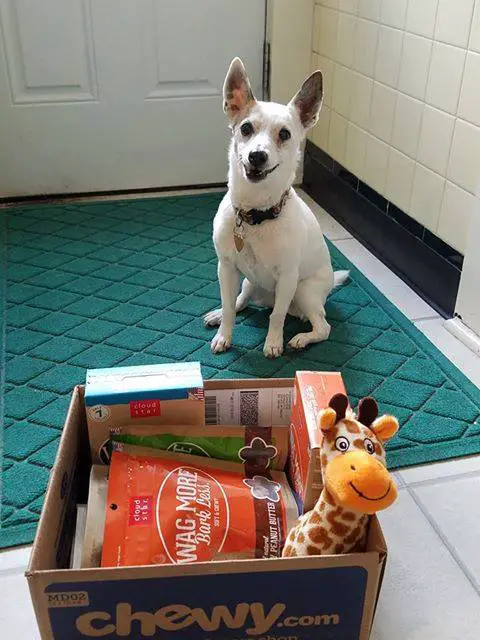Table of Contents
We all want what’s best for our pups — the best equipment, the best activities, the best training, and yes, the best food.
*This post may contain affiliate links. As an Amazon Associate we earn from qualifying purchases.
But not all foods are created equal. And not all treats, when you look at them up close,
Getting the best nourishment for your dog means understanding what your dog needs — not just what they want. It also means knowing what’s out there.
Fortunately, the information isn’t too hard to find.
What Does a JRT Need?
Just like people, dogs have specific nutritional needs. They need a certain number of calories to stay healthy and active. They also need a balance of macronutrients, that is, protein, fat, and carbohydrates. The exact balance will depend on your dog’s age, weight, and activity level.
Beyond that, you may consider other factors, such as organic production, preparation techniques, a special diet your vet may recommend, and so on

So, what are the basic nutritional needs of your standard Jack Russell?
- For puppies, 800 to 900 calories spread over four to six meals, with a nutritional balance of 22 percent protein and 18 percent fat.
- For adult dogs weighing 13 to 17 pounds, 450 to 650 calories divided into two to three meals, with a balance of 18 percent protein and five percent fat.
Do you have to count the treats?
Yes. Yes, you do.
The more you start reading nutritional labels, the more variation you’ll see. Few commercial dog foods meet these standards exactly. But with the right balance of treats and high quality foods, you can come close.
There’s Food and Then There’s Food
What makes a healthy, balanced dog food? Can you make your own? How do you pick a good one?

Read the labels, by all means. But if you want to expand your vision beyond what’s on the shelves of your local grocery or pet store, there are resources for that, too.
Dog Food Advisor, for example, has hundreds of reviews of different commercially-produced dog food. You can comb through “best of” lists, and read individual reviews of products you might already be familiar with. You can also keep up to date with recalls.
Best of all, the reviews will give you an in-depth look at each brand’s pros, cons, and nutritional analysis.
Watchdog Labs maintains a database of controversial dog food ingredients. If you’re wondering what that unfamiliar ingredient is, they can tell you. They can also tell you why you might not want it in your dog’s food.
Ingredients: the good and the bad
Now here is where things can get tricky. Dog food manufacturers, just like companies who make processed human food, use a lot of ingredients that most of us don’t recognize by name. And that’s by design.
Manufacturers may hope you’re not doing your research. They may hope that if they use an alternate name for a common ingredient, consumers won’t recognize that ingredient for what it is.
And that can be bad news for you and your dog.

Look at the main ingredients
When manufacturers list ingredients, they start with the ingredients that are present in the largest amounts. So the first five ingredients are generally the ones that make up the main part of any dog food.
What’s in those first five ingredients? Is it meat? Or is it a filler like corn or rice? Or is it something else altogether?

Another good guiding principle is this: the fewer ingredients, the better.
Sometimes a vet will recommend limited-ingredient dog foods for certain medical conditions, particularly allergies.
But aside from that, as long as a dog food has the proper nutritional balance, fewer ingredients means less chance of something you don’t want, such as fillers and preservatives.
Protein
Protein is an important fuel source for dogs. It’s also a vital building block for muscles, blood, skin, cartilage, and more.

Most experts believe that protein derived from meat sources is better for dogs than plant-based proteins. So most premium quality dog foods have meat as one of the primary ingredients.
Vegan dog foods are controversial. Although dogs aren’t obligate carnivores like cats are, meat sources (with one exception) provide more protein per calorie than vegetable protein sources.
So when you’re looking at dog foods, don’t just think about how much protein the food contains, also think about where that protein comes from, as well.
Fillers
If you read the labels of lower-quality dog foods, you’ll find a lot of fillers. Fillers bulk up a product without adding much, nutrition-wise. That means it’s cheaper to produce. Unfortunately, filler-rich dog foods can cheat dogs of necessary nutrition.

Check out those first five ingredients. Do they contain a filler such as:
Corn meal - Soybean meal
- Meat or bone meal
- Wheat mill run, middlings, or “mids” (a by-product of wheat milling)
- Brewer’s rice (a milling by-product)
If so, then you’d probably do better looking for a higher quality food.
Controversial ingredients
Then there are some ingredients that you might want to avoid. Some, like plant or animal meal, aren’t very nutritionally dense. Others, like the preservatives BHA and BHT, are downright dangerous.
Here are some of the worst offenders:
- Sweeteners like fructose, corn syrup, or sugar (no nutritional value)
- Ethoxyquin (a preservative; causes organ damage, a possible carcinogen)
- Propylene glycol (reduces moisture and bacteria; possible carcinogen, among other things)
- BHA and BHT (preservatives; organ damage, a possible carcinogen)
- TBHQ, or tertiary butylhydroquinone (preservative; linked to serious illnesses)
Carageenan (a binding ingredient;possible carcinogen, can cause intestinal inflammation)
Dog Food Types
So, what should you feed your dog? The number and types of foods you might encounter can be intimidating. But common sense and a little research can help you to make sense of it all.

Celebrity dog foods
You can’t go far without seeing some celebrity’s face selling a product. Sometimes it seems like that’s all celebrities seem to do. And a number of them have entered the dog food game, as well.
Are celebrity dog foods worth the sometimes higher price? What do they have that other dog foods don’t?
That, apparently, comes down to the celebrity.

For some celebs, it seems, licensing their name to a dog food company is the beginning and end of it. Others, though, seem to take a personal interest in the products attached to their names.
As always, it’s important to read the label and know what you’re getting. Consider the following:
How does the macronutrient balance look?
Does it use a plant-based or animal-based protein source? Is that what you want?
Are there any controversial ingredients like carrageenan, corn, or artificial colorings, flavorings, or preservatives?
All of these considerations should take precedence over any endorsement, no matter who the celebrity.
Premium dog food

When a lot of us see the word “premium,” we think “expensive.” Unfortunately, the word “premium” doesn’t have a legal definition. This means that anyone can slap that word onto their food to try to make a buck.
But truly premium dog foods have a few things in common. These include:
- A
high quality protein source (meat, rather than meat meal, bone meal, or plant proteins) - A smaller number of easily-recognizable natural ingredients
- No preservatives or fillers
- Chelated minerals (easier to absorb)
- Fruits and/or vegetables for fiber, rather than mill by-products
It may cost a bit more, but isn’t your dog worth it?
Prescription food
If your dog is generally healthy, then you don’t need to think about prescription dog food. But if your dog suffers from specific health conditions like diabetes, allergies, or heart or kidney conditions, then your vet may recommend it.
For many chronic health conditions, diet can be one of the keys to management. Prescription dog foods can be expensive, but if your vet recommends them, they can be a lifesaver. Literally.
Raw diet
If your dog were living in the wild, all of his or food would be raw. It would be hunted or scavenged, not out of a bag or can.

Feeding a raw food diet is an increasingly popular option. It can be a bit labor intensive, but for some families, it’s worth it. Some reported benefits of a raw diet include:
- Weight management
- Cleaner teeth
- More energy
- Better skin and coat
- Improved digestion
- Relief from allergies.
The problem with a raw food diet, though, is that you have to plan it carefully. It’s not enough to just toss some ground beef into your dog’s bowl.
Remember that nutritional balance? Calories, fat, protein and carbohydrates? If you choose to feed your dog raw, you’re going to have to make those calculations yourself.
And for some people, it’s well worth it.
Just make sure to do your research. Don’t switch your dog’s diet all at once; it may cause tummy upset. And don’t forget the fruit and veg.
What About Snacks?
We all love snacks, and your dog is no different. Fortunately, if you choose right, snacks can be a part of a healthy diet.

Fruits and vegetables
Can your dog eat fruits and vegetables?
Yes!
And they like them, too!
If your dog is looking to beat the heat, try some chilled watermelon or a frozen banana.

Or maybe your pup is watching his or her sugar intake. How about some antioxidant-rich cucumber or crunchy, vitamin-packed green beans?
Your dog can eat lots of different vegetables, actually. Some, however, like members of the onion family, you should absolutely avoid.
Supplement treats
Has your vet recommended dietary supplements for your dog?
Some conditions, like arthritis, can benefit from specific supplements. And the dog treat industry has risen to the occasion.

You can find treats that contain glucosamine and chondroitin for arthritis. There are CBD or melatonin treats for anxiety. You can also find all-purpose treats that supplement vitamins and minerals.
The important thing, as always, is to know your dosages and follow your veterinarian’s advice.
Treat subscription boxes

Can’t find the right treats? Or maybe you’ve been looking for something new to try?
How about a subscription box?
Companies around the world will ship selections of food and
Make your own

Can you make your own dog treats? Of course you can! And it’s easier than you think.
First, pick your form. Want to try your hand at doggy baking? Or maybe a cool frozen treat is more on your dog’s mind.
Next, pick your base. Whatever form your treat takes, these ingredients are always pack-pleasers:
- Peanut butter
- Meat
broth - Pumpkin
- Bananas
- Tuna
- Cheese
Finally, grab a few recipes and get started!
So Many Treats, So Little Time!

If you know what to look for, you can fashion a diet for your dog that meets all their nutritional needs — and their needs for variety and fun, as well.
So, what’s in your dog’s snack bowl?
Featured Image: by An Ragaire, via Pexels, on Pexels License

